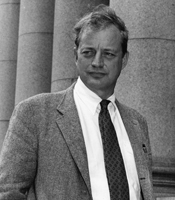Alum’s book credits CIA analyst with uncovering Vietnam “numbers gap””
Sam Adams claimed the U.S. military misled the public

Sam Adams, a CIA analyst from 1963 to 1973, had a passion for accuracy — and a huge problem with the Pentagon’s estimates of Viet Cong forces during the Vietnam War. Responsible for the daily enemy assessment report, Adams believed that the U.S. brass was consistently fabricating low numbers of South Vietnamese Communist soldiers to demonstrate supposed progress against the enemy.
In his recently released book Who the Hell Are We Fighting? The Story of Sam Adams and the Vietnam Intelligence Wars, BU alumnus C. Michael Hiam (GRS’87) chronicles Adams’ growing conflict with his superiors. The battle sidetracked Adams’ CIA career — he was threatened with dismissal 13 times — until he finally left the agency. He then went public with a cover story in the May 1975 Harper’s magazine. Adams was also the primary source for a 1982 CBS documentary on the Vietnam “numbers gap,” which resulted in the famous libel trial Westmoreland v. CBS in 1984.
After the airing of the documentary, The Uncounted Enemy: A Vietnam Deception, which alleged that Army General William Westmoreland and others had undercounted Viet Cong troop strength to maintain popular support for the war, Westmoreland sued Adams and journalist Mike Wallace for $120 million in damages. Adams was a consultant on the discovery process of the lawsuit. Westmoreland dropped his suit, however, before the case could be sent to the jury. Both sides declared victory.
“I had always felt his story would be an incredible book,” says Hiam, a 43-year-old psychologist who lives in Newton, Mass. “Sam Adams was going to write it, but he died before he got the chance. The basics of his story are known, but no one had put everything all together in one chronicle.” Adams, who had set aside work on his memoir to help with the CBS documentary and the trial, died of a heart attack in 1988. Hiam, who is Adams’ godson, spent more than a month researching the Adams papers at BU’s Howard Gotlieb Archival Research Center, which contain 9,745 pages of trial transcripts and other documents.
Hiam traces Adams’ strong and stubborn personality to his childhood days in boarding schools, including Saint Mark’s School in Westborough, Mass. “He was a bit of a slacker, but when he put his mind to something, he focused completely on it,” Hiam says. A Civil War buff, Adams was compulsive about all the details that influenced the outcome of the war, such as supply lines and railroad lines. “He was a mediocre student, but he suddenly rocketed to the top of his class academically his senior year,” says Hiam. But at Harvard University, where he majored in history, he skipped classes and generally accepted “the gentleman’s C,” according to his godson.
After graduating in 1955 and then a stint in the Navy, Adams drifted, going from being a ski bum to studying at Harvard Law School to banking. But when he wandered into his CIA job in 1963, he had found his true calling. “He liked numbers and statistics,” Hiam says, “even though he hadn’t taken a math course beyond algebra.”
In 1966 Adams began discovering that the official U.S. numbers of Viet Cong combatants didn’t add up. Time and time again he uncovered intelligence suggesting an enemy army more than twice as big (about 400,000) as the government claimed, and when his superiors ignored and then berated him, he smuggled the documents out of the office.
After he was forced to resign from the CIA in 1973, he became a professional dissident, and he hid many of the documents in a leaf bag buried on his wife’s cattle farm in Virginia. “It was fascinating to see the worm holes in some of the papers at the Gotlieb Center,” says Hiam. “Many of the pages were blackened with rot.” Alas, the bag and its contents began to decompose, but there was enough evidence to show that the CIA’s Military Assistance Command, Vietnam, was playing a numbers game with the public.
“It’s amazing how relevant this story is to what is happening in Iraq,” says Hiam, pointing to the uproar over claims by President George W. Bush and others before the war that Iraq possessed weapons of mass destruction — and accusations that the United States used faulty intelligence as its rationale for invading the country. “It shows the need for objective, nonpoliticized intelligence,” Hiam says, “not intelligence based on what people want to see but that just isn’t there.”